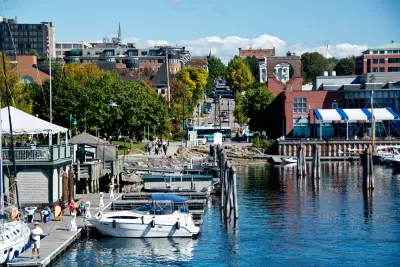The Vermont State Senate voted unanimously to approve legislation that would reduce barriers to more compact residential development. The Vermont House of Representatives is up next.

"Vermont is now proposing legislation that will make it easier to build compact housing types in downtowns, neighborhoods, and village centers throughout the state," according to an article by Rober Steuteville.
The bill (S.237), has already cleared the State Senate with unanimous support, reports Steuteville, and would support missing middle housing types like multiplexes, ADUs, and small-lot units—in walkable places.
"The legislation addresses specific barriers to more compact development—including lot sizes that make housing exclusive and unaffordable," explains Steuteville of S.237.
Specifically, the bill would ban zoning laws that set minimum lots sizes greater than an eighth of an acre (5,400 square feet) where water and sewer service is available. It would also allow 2-unit dwellings on such lots. Where zoning laws specifically allow duplexes, quadraplexes would also be permitted. By loosening restrictions on accessory dwelling units (ADUs), ADUs would be more practical to build. If property owners lease parking separately, the minimum parking requirements would be cut in half.
Steuteville's description of the current state of zoning in Vermont notes that the traditional development patterns cherished in the state's communities, all relatively small in population, have been rendered illegal by the status quo of zoning. The state is also dealing with rising housing costs. "The median price of a house in Vermont has risen rapidly since 2016 and now is $261,000," according to Zillow data cited by Steuteville in the article.
FULL STORY: State moves forward with zoning reform

Planetizen Federal Action Tracker
A weekly monitor of how Trump’s orders and actions are impacting planners and planning in America.

Chicago’s Ghost Rails
Just beneath the surface of the modern city lie the remnants of its expansive early 20th-century streetcar system.

San Antonio and Austin are Fusing Into one Massive Megaregion
The region spanning the two central Texas cities is growing fast, posing challenges for local infrastructure and water supplies.

Since Zion's Shuttles Went Electric “The Smog is Gone”
Visitors to Zion National Park can enjoy the canyon via the nation’s first fully electric park shuttle system.

Trump Distributing DOT Safety Funds at 1/10 Rate of Biden
Funds for Safe Streets and other transportation safety and equity programs are being held up by administrative reviews and conflicts with the Trump administration’s priorities.

German Cities Subsidize Taxis for Women Amid Wave of Violence
Free or low-cost taxi rides can help women navigate cities more safely, but critics say the programs don't address the root causes of violence against women.
Urban Design for Planners 1: Software Tools
This six-course series explores essential urban design concepts using open source software and equips planners with the tools they need to participate fully in the urban design process.
Planning for Universal Design
Learn the tools for implementing Universal Design in planning regulations.
planning NEXT
Appalachian Highlands Housing Partners
Mpact (founded as Rail~Volution)
City of Camden Redevelopment Agency
City of Astoria
City of Portland
City of Laramie





























